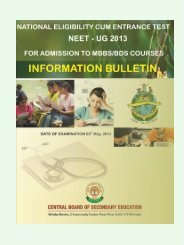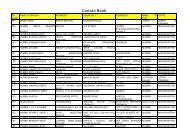Examination Syllabus - NEET-UG, 2013
Examination Syllabus - NEET-UG, 2013
Examination Syllabus - NEET-UG, 2013
Create successful ePaper yourself
Turn your PDF publications into a flip-book with our unique Google optimized e-Paper software.
UNIT I: Physical World and Measurement<br />
PHYSICS<br />
CONTENTS CLASS XI SYLLABUS<br />
Physics: Scope and excitement; nature of physical laws; Physics, technology and society.<br />
Need for measurement: Units of measurement; systems of units; SI units, fundamental and derived units. Length, mass and<br />
time measurements; accuracy and precision of measuring instruments; errors in measurement; significant figures.<br />
Dimensions of physical quantities, dimensional analysis and its applications.<br />
UNIT II: Kinematics<br />
Frame of reference, Motion in a straight line; Position-time graph, speed and velocity. Uniform and non-uniform motion,<br />
average speed and instantaneous velocity. Uniformly accelerated motion, velocity-time and position-time graphs, for<br />
uniformly accelerated motion (graphical treatment).<br />
Elementary concepts of differentiation and integration for describing motion. Scalar and vector quantities: Position and<br />
displacement vectors, general vectors, general vectors and notation, equality of vectors, multiplication of vectors by a real<br />
number; addition and subtraction of vectors. Relative velocity.<br />
Unit vectors. Resolution of a vector in a plane-rectangular components.<br />
Scalar and Vector products of Vectors. Motion in a plane. Cases of uniform velocity and uniform acceleration- projectile<br />
motion. Uniform circular motion.<br />
UNIT III: Laws of Motion<br />
Intuitive concept of force. Inertia, Newton’s first law of motion; momentum and Newton’s second law of motion; impulse;<br />
Newton’s third law of motion. Law of conservation of linear momentum and its applications.<br />
Equilibrium of concurrent forces. Static and Kinetic friction, laws of friction, rolling friction, lubrication.<br />
Dynamics of uniform circular motion. Centripetal force, examples of circular motion (vehicle on level circular road, vehicle<br />
on banked road).<br />
UNIT IV: Work, Energy and Power<br />
Work done by a constant force and variable force; kinetic energy, work-energy theorem, power.<br />
Notion of potential energy, potential energy of a spring, conservative forces; conservation of mechanical energy (kinetic and<br />
potential energies); non-conservative forces; motion in a vertical circle, elastic and inelastic collisions in one and two<br />
dimensions.<br />
UNIT V: Motion of System of Particles and Rigid Body<br />
Centre of mass of a two-particle system, momentum conservation and centre of mass motion. Centre of mass of a rigid<br />
body; centre of mass of uniform rod.<br />
Moment of a force,-torque, angular momentum, conservation of angular momentum with some examples.<br />
Equilibrium of rigid bodies, rigid body rotation and equation of rotational motion, comparison of linear and rotational<br />
motions; moment of inertia, radius of gyration. Values of M.I. for simple geometrical objects (no derivation). Statement of<br />
parallel and perpendicular axes theorems and their applications.<br />
UNIT VI: Gravitation<br />
Kepler’s laws of planetary motion. The universal law of gravitation. Acceleration due to gravity and its variation with<br />
altitude and depth.<br />
Gravitational potential energy; gravitational potential. Escape velocity, orbital velocity of a satellite. Geostationary<br />
satellites.





